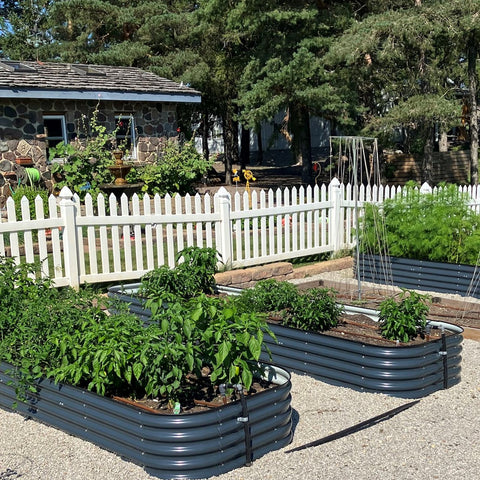Tips from Olle Garden Bed: How To Make Your Vegetables Thrive in the Heat Wave
During the worst of summer, keeping our vegetable garden or distribution vibrant and prosperous feels like a battle. As the temperature continues to rise, many of us may feel that we spend more time watering than we want. he following content also has some reference value for raised garden beds.
Overheating and drought have similar effects on our gardens, as plants struggle to absorb enough water and require additional attention. All of these additional watering not only takes time, but also often leads to water shortages or hose bans during droughts, so it is important to use water as effectively as possible. Here are some convenient tips that can help you reduce the time spent watering vegetables while helping them thrive under these difficult conditions.
Apply generous coverings
Applying thick mulch around vegetable plants, such as compost, manure, tree bark, or straw mulch, will help maintain soil moisture by reducing evaporation. This in turn helps to keep the root zone moist and the soil below the cover cool. Covering also has the additional benefit of inhibiting weeds, which compete with your crops for water. Check out our convenient guide to learn how to make your own nutrient rich water retaining compost, perfect for mulching.
Watering at the right time
Watering at the right time can have a huge impact on the amount of water you need to use and the ability of plants to absorb water. Watering in hot weather can cause a large amount of water to evaporate directly from the soil surface before plants have a chance to absorb it. Any water absorbed by plants will soon be lost through transpiration.
The best time for watering in summer is in the evening, when the evaporation will be minimized, and the plants will absorb the water in the soil all night. If this is impossible, the next best watering time is in the early morning, before the sunlight is strong.
Build watering wells around thirsty plants
Whenever you plant large and thirsty vegetables such as zucchini or pumpkin, it is best to create a raised "donut" soil around the plant, concentrating water at the bottom of the plant and minimizing runoff. However, you can go further by creating a deep well next to the bottom of the plant.
Simply take an old beverage bottle, yogurt bucket, or similar item, cut off the base, dig a hole next to the plant, and then sink the bottle into it, with the narrower end facing down. When watering, you can simply guide the water into these "wells". This creates a soilless shortcut for water to flow directly to the deep root zone, greatly improving watering efficiency by reducing evaporation on the soil surface. It also encourages plants to grow deeper roots, thereby preventing them from drying out so quickly.
Consider planting location
Some of the most thirsty and wilting vegetables do not need to be planted in sufficient sunlight. This applies to many leafy crops, such as lettuce, other salads, spinach, and beets, which are all very happy in some shadows. Planting these crops in the scorching sun will only cause them to dry out faster, making them easier to get stuck. Try planting leafy crops in areas that are shaded for some time of the day, or between them and larger vegetables such as zucchini or rows of shaded beans.
Vegetables grown in containers using water retaining particles
If you plant any vegetables in a flowerpot or basket, it is best to use water retaining granules. The same applies to the display of decorative containers. These clever particles are completely non-toxic, biodegradable, and safe for children and pets. They can be simply added to the compost according to the dosage given on the packaging. They will absorb 80 times their weight of water, improving the water retention capacity of compost - which means less watering frequency At the same time, it does not affect drainage. Plants only utilize water reserves when needed.
You can also use our special water retaining compost as a shortcut to keep containers and baskets hydrated for longer periods of time.
Minimize dependence on tap water as much as possible
A thirsty garden will consume a large amount of water, which not only increases your water bills but also leads to regional or national water shortages. Therefore, minimizing dependence on tap water is a good idea - sometimes even enforced through hose bans.


